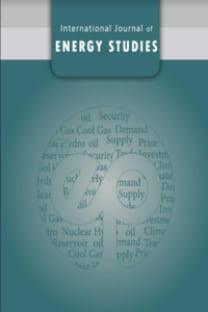Strategic Approaches To Unconventional Resources To Meet The Turkish Energy Demand
Increasing demand in energy makes the world revolve around it. Major oil companies have been researching all around the world as to increase reserve and production. What could we do to find more reserves? Thinking backwards is a way to discover new methodology and associated new technology. That is how unconventional methods stepped in to petroleum industry. As it is known, conventional methods are only able to extract oil from reservoirs with fair enough permeability. Unconventional methods focus on those reservoirs and or source rocks within the range from little down to micron level permeability.What is challenging when we consider unconventional production? As known, associated technology depends on horizontally drilled wells and fracturing the rock to suck hydrocarbons out to surface. Once the horizontal wells are drilled, water is injected through by powerful pumps to crack the rock. Sand is a necessity to keep the cracks open and some chemical additives provides stability of the cracks to efficiently remove water and gas out, they also prevent bacteria growth. The amount of injected water, sand and additives play a key role since millions of tons of water and hundred thousands of tons of associated sand and additives are used in the hydraulic fracturing process. At this point two main concerns should be addressed. First, the wastewater that is pumped out during production requires high attention due to the chemicals it contains. The chemicals pose serious threats to human health and have to be handled carefully. It could be either recycled for usage in another fracking procedure or injected into a sealed reservoir to be sensitive to the environment. To define impermeable zones, which will trap re-injected wastewater, a thorough stratigraphic evaluation has to be achieved successfully. A leaking disposal formation is unwanted as it is certainly undesired to see those wastes pollute our environment. Second, it has been reported also that there has been an increase in the seismic events in those areas where unconventional technology is used. Tactfully, cracking the rock happens to affect natural balance and causes to stimulate more earthquakes. That information points out that location for unconventional wells have to be chosen far from active fault systems as fracturing might trigger earthquakes with higher magnitude.As we elaborate Turkey’s energy supplies, demands and politics regarding the subject, we might try to answer a couple of questions as follows: How much of unconventional potential Turkey has? Or, can Turkey double its proven reserves by this methodology? Answers are not complicated as one might think. Known facts about unconventional studies suggest that they require using a unique but expensive technology and raise important environmental concerns that might slightly change our lives. A few companies worldwide have the technology required for unconventional hydrocarbon production. Turkey has to pay for the expensive technology for its unconventional reserves. On the other hand, information regarding source rocks of Turkey is still questionable and poorly defined. Suitable source rocks need to be examined thoroughly as in thickness and areal extent before going too deep into unconventional business. As a result, Turkey has to carefully examine and properly define its unconventional resources before thinking that unconventional methods are the solution to ease high costs of energy import. In this study, we share brief information from a technical window regarding global unconventional energy practices, how it affects the market, how it shapes Turkey’s energy policies and further on if Turkey have enough reserves to cover its energy demands. Analysis of the technology used and its economic aspects will certainly point out how Turkey’s unconventional future will change its energy supply and security chain.
Keywords:
Unconventional Resources, Turkish Energy Demand,
___
- REFERENCES Nicole Branan, “Exploration & Innovation: Geoscientists Push the Frontiers of Unconventional Oil and Gas”, The University of Texas at Austin, Jackson School of Geosciences, 2008; accessible from http://www.jsg.utexas.edu/news/2008/04/exploration-innovation-geoscientists-push-the-frontiers-of-unconventional-oil-and-gas/ PacWest, “Shale/Unconventional Resources”; accessible from http://pacwestcp.com/education/shaleunconventional-resources/ Halfdan Carstens, “A World of Plenty”, GeoExPro; accessible from http://www.geoexpro.com/articles/2013/08/a-world-of-plenty Marathon Oil Corporation, “Reservoir Management”; accessible from http://www.marathonoil.com/Technology/Technology/Reservoir_Management/ Donald Hertzmark, “Unconventional Gas Riles and Refigures the World Energy Market: North America (Part I)”, Master Resource, 2011; accessible from https://www.masterresource.org/shale-gas-energy-sources/unconventional-gas-north-america/ Tracy Crawford, “Hydraulic Fracturing: What is hydraulic fracturing?”, Green Plug District; accessible from http://greenplug.nu/hydraulic-fracturing-what-is-hydraulic-fracturing/ Pioga, “Hydraulic Fracturing Process”; accessible from http://www.pioga.org/education /hydraulic-fracturing-process/ Illinois Chapter, “Fracking News”; accessible from https://sierraclubillinois.wordpress.com /tag/fracking/ Mirko van der Baan, David Eaton and Maurice Dusseault, “Microseismic Monitoring Developments in Hydraulic Fracture Stimulation”, Intech; accessible from http://www.intechopen.com/books/effective-and-sustainable-hydraulic-fracturing/microseismi c-monitoring-developments-in-hydraulic-fracture-stimulation By Al Granberg and Krista Kjellman Schmidt, “Infographic:What is Hydraulic Fracturing?”, ProPublica; accessible from http://www.circleofblue.org/waternews/2010/science-tech/climat e/hydraulic-fracturing-infographic/ Richard Liroff, Danielle Fugere, Lucia von Reusner, Steven Heim, “Disclosing the Facts 2014: Transparency and Risk in Hydraulic Fracturing Operations”, Investor Relations; accessible from http://www.slideshare.net/AsYouSow/dtf2014-embargoed Seth Busetti and Ze’ev Reches, “Geomechanics of hydraulic fracturing microseismicity: Part 2. Stress state Determination”, AAPG Bulletin, v. 98, no. 11 (November 2014); accessible from http://earthquakes.ou.edu/reches/Publications/Busetti%202014%20Part%20II.pdf Vincent M. C., “Five Things You Didn’t Want to Know about Hydraulic Fractures”, Intech; accessible from http://cdn.intechopen.com/pdfs-wm/44148.pdf http://www.telegraph.co.uk/news/earth/energy/ U.S. Environmental Protection Agency, “Class I Industrial and Municipal Waste Disposal Wells”; accessible from http://www.epa.gov/uic/class-i-industrial-and-municipal-waste-disposal-wells U.S. Energy Information Administration. Indrajit Das1 and Mark D. Zoback, “Long-period, long-duration seismic events during hydraulic stimulation of shale and tight-gas reservoirs — Part 1: Waveform characteristics”, Geophysics, VOL. 78, NO. 6 (NOVEMBER-DECEMBER 2013). D.V. Satya Gupta, “Unconventional Fracturing Fluids”, Baker Hughes, 2010. Tony Ingraffea, “Fracing In Practice in Unconventional Shale Gas Wells”, Cornell University, 2011; accessible from http://www2.cce.cornell.edu/naturalgasdev/documents /cheme%206666%20lecture%20series-2011/cheme%20666609hfpractice%20in%20shaleclas s%20notes.pdf
- Yayın Aralığı: Yılda 4 Sayı
- Başlangıç: 2016
- Yayıncı: Türkiye Enerji Stratejileri ve Politikaları Araştırma Merkezi (TESPAM)
